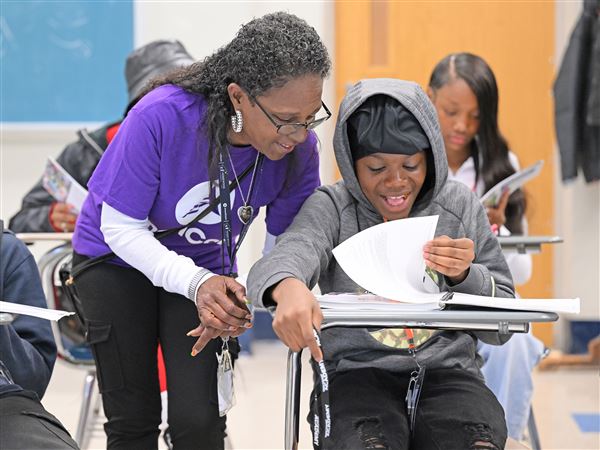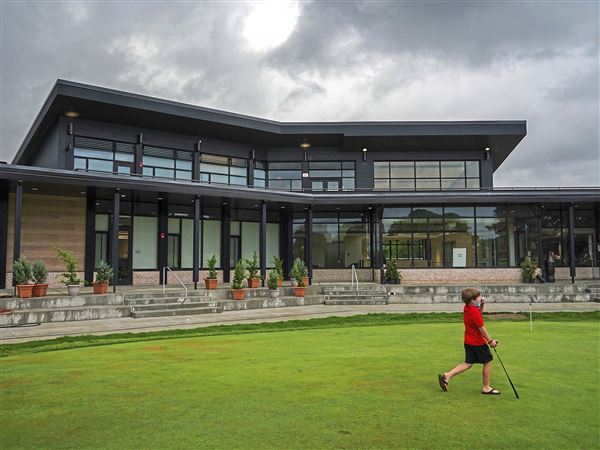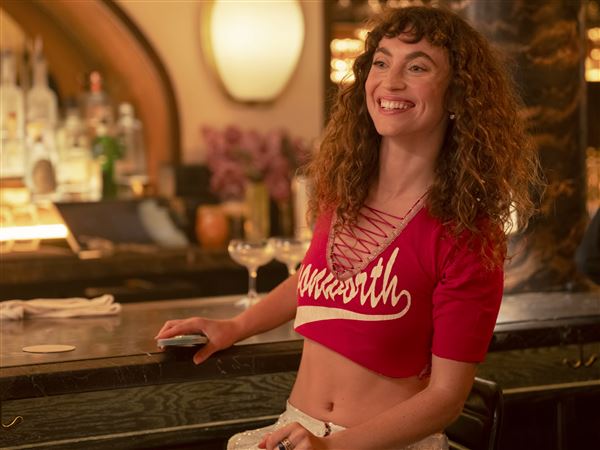Paul Binai is an observer, historian, curator and aesthete, qualities that have informed him as an artist but also kept him cloistered from the world of big art which builds reputation.
That makes for a refreshing purity of vision -- uncompromising some would say -- but the loss is that his evocative work isn't better known outside select art circles here, and in New York City and France, where he has gallery representation.
The exhibition, "Paul Binai: Fifty-Year Retrospective," at the University Museum, Indiana University of Pennsylvania, is a well-deserved recognition of his achievements, ranging from his earliest painting to a sampling of the collage work he's turned to in more recent years.
"Blue Shutters" of 1952 was Mr. Binai's first painting. The scantily dressed women peering out a window at night was provocative due to its subject matter but also due to its representational quality at a time when Abstract Expressionism was in ascendency.
The painting was completed after Mr. Binai, then 19, read Truman Capote's "Other Voices, Other Rooms," which included a transvestite who stood before a window wearing women's clothes. The artist was trying to "convey the feeling of Southern decadence," he told Brenda Mitchell, an IUP associate professor of art history who wrote the exhibition catalog essay.
Capturing the "feeling" of the subject -- the emotive quality that resides within and defines it -- continues through Mr. Binai's oeuvre, in later years playing out in spectacular color associations that seduce the eye even before the often shattering scene becomes apparent.
If Mr. Binai wasn't following the contemporaneous fashion of abstraction, he was way ahead of the multicultural curve because of his rather exotic personal history, recorded in the show's informative, illustrated catalog.
His paternal grandfather was the Siamese (now Thai) ambassador to Germany and the Imperial Court of Russia before 1900, and his paternal grandmother was one of the first women admitted to the medical profession in Europe. His father, Prayong Pamon Montri, was born in Berlin in 1898, spent part of his childhood in Moscow, then relocated with his twin brother to Siam where the King adopted them.
Mr. Binai's father came to the U.S. in the 1920s to study at Lehigh University in eastern Pennsylvania, where he met and married Frances Sarah Flory, a Mayflower descendent who lost her U.S. citizenship in 1924 because of the marriage.
In the 1930s, the family moved to Indianapolis where Mr. Binai's father directed a research facility. During World War II, he developed a process for electroplating the lining of airplane bearings while designated an "enemy alien," according to the catalog. His father was repeatedly rejected in his efforts to become a naturalized U.S. citizen because Siamese were considered a distinct race ineligible for citizenship. In the 1950s, he finally became a citizen and changed his name to Walter Binai.
Paul Binai was born in 1932 in Lancaster, and resides in Indiana, Pa. He earned bachelor's and master's degrees in fine art from Indiana University in Bloomington, and later studied at the School of Fine Arts at Yale University and at the School of Fontainebleau, France. He has taught at Purdue University, served as artist-in-residence at Fontainebleau and at Carnegie Mellon University, and been curator at the Detroit Institute of Arts, Carnegie Museum of Art and Southern Alleghenies Museum of Art.
In 1994, he withdrew from such positions to do what he'd wanted to do "since I was a little kid ... paint and draw," he told this reporter in 2002.
Mr. Binai has been given extensive solo exhibitions by the University of Pittsburgh and Penn State University, New Kensington. He had exhibited with the Associated Artists of Pittsburgh, but cut ties with the organization due to what he perceived as insensitive treatment of members.
The artist's commitment to principle is evident in inflamed works that bluntly portray mankind's most depraved actions and most despairing moments. In a series including "The Factory" and "Gehenna I," Mr. Binai addresses the Holocaust through silhouetted figures moving against a pulsing background of buildings built of layers of primary colors, forming a tactile surface that is vibrant and simultaneously grimly saturated.
While acknowledging his debt to the German Expressionists, Mr. Binai's paintings are uniquely infused with empathy and analysis, social critique and sometimes droll humor.
Works inspired by tabloid headlines -- such as "The Execution of Ruth Snyder" by electric chair in 1928, or the "Peaches and Daddy" series drawn from the scandalous 1920s marriage of a 50-year-old New York millionaire and 15-year-old girl -- keep company with profound commentary like the 60-by-50-inch "Dissidents," three hanging silhouetted bodies suspended against a heavily textured golden background.
At times he is prescient, as with the 1995 painting "China Over Egypt" in which a formidable assault rifle stamped "China" floats in a dark blue sky over a red landscape of pyramids.
Mr. Binai's great achievement is to reveal truth, not so much in specific acts of cruelty but by probing the nature that produces them. The almost ghoulish, sometimes cunning, self-satisfied faces in paintings such as "Olga and Tatiana," or of various soldiers, are stripped of the usual socially polite cover. And we are left to consider the stark and unsettling reality.
The exhibition continues through Dec. 3 in Sprowls Hall, 470 S. Eleventh St., on the IUP campus. Admission is free. Hours are 2 to 6:30 p.m. Tuesday, Wednesday and Friday; noon to 7:30 p.m. Thursday; and noon to 4 p.m. Saturday. For information, call 724-357-2397.
Douglas Hyland, director of the New Britain Museum of American Art, Connecticut, will give a gallery talk in the exhibition "The Tides of Provincetown: Pivotal Years in America's Oldest Continuous Art Colony (1899-2011)" at 7 p.m. Friday at the Westmoreland Museum of American Art, 221 N. Main St., Greensburg. Free. Information: www.wmuseumaa.org or 724-837-1500.
An opening reception for "Material Witness: Hannelore Baron, Donna Sharrett, Vanessa German" will be held from 6 to 8 p.m. Thursday at the Pavel Zoubok Gallery, 533 W. 23rd St., New York City. The exhibition continues through Dec. 17 (212-675-7490).
First Published: November 16, 2011, 10:00 a.m.














